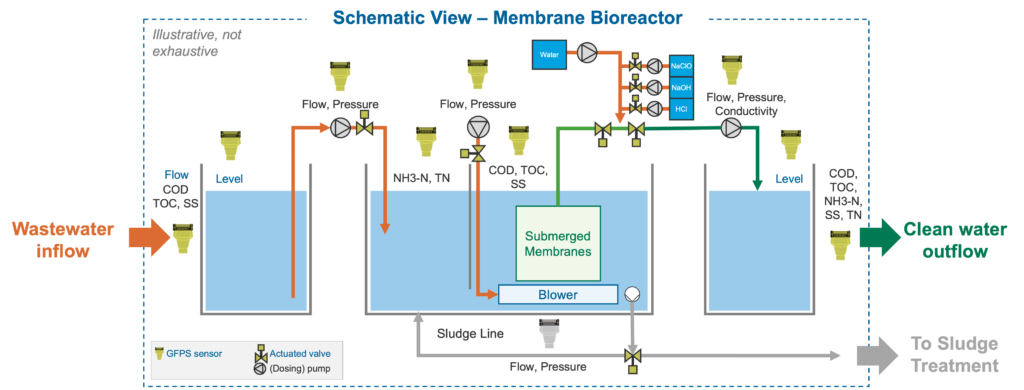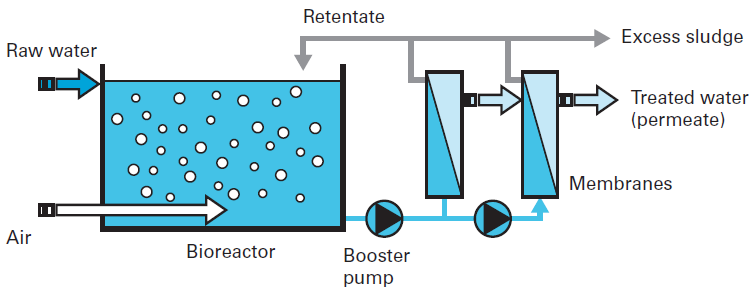Troubleshooting Common Issues with Membrane Bioreactor Systems
Membrane Bioreactors Discussed: Reliable Solutions for Tidy Water
Membrane layer bioreactors (MBRs) have actually emerged as an innovative remedy for attending to the pressing challenges of wastewater therapy - Membrane Bioreactor. By incorporating biological procedures with sophisticated membrane filtration, MBRs not only boost the high quality of cured water however additionally minimize the spatial needs of treatment centers.

What Are Membrane Bioreactors?
Membrane layer bioreactors (MBRs) are advanced wastewater therapy systems that incorporate organic deterioration procedures with membrane layer purification innovation. This assimilation enables the efficient elimination of pollutants from water, making MBRs a recommended option in different applications, including community wastewater treatment and commercial effluent management.

Among the vital advantages of MBRs is their capacity to create top notch effluent, often suitable for reuse in watering or industrial procedures. Additionally, MBRs call for a smaller sized footprint contrasted to standard therapy systems, making them optimal for urban setups where room might be restricted.
Furthermore, MBRs can efficiently deal with differing influent tons and are much less vulnerable to the results of toxic shocks. These features add to their growing appeal as a sustainable service for addressing the enhancing need for tidy water while decreasing ecological influences.
How Membrane Bioreactors Work
While the procedure of membrane layer bioreactors (MBRs) might seem complex, it essentially revolves around the synergy between biological procedures and membrane filtration. MBRs incorporate a biological treatment procedure, typically activated sludge, with a membrane splitting up device to treat wastewater efficiently.
In an MBR system, wastewater is first introduced right into a bioreactor where microorganisms degrade natural matter and other pollutants. The organic task minimizes the concentration of pollutants while promoting the development of biomass. Following this organic therapy, the blended liquor is subjected to membrane filtering, which can be microfiltration or ultrafiltration, depending upon the wanted effluent quality.
The membrane layers work as a physical barrier, permitting water and tiny solutes to pass while preserving suspended solids and bigger particles. This makes it possible for the system to maintain a high focus of biomass within the activator, boosting the therapy effectiveness.
Furthermore, the constant splitting up of treated water from the biomass promotes a small layout and reduces the impact of the therapy center. In general, the mix of biological deterioration and membrane layer purification in MBRs leads to efficient and trusted wastewater treatment, ensuring top notch effluent suitable for numerous applications.
Advantages of MBR Modern Technology
One of the essential advantages of membrane bioreactor (MBR) innovation is its ability to generate top notch effluent with a dramatically lowered footprint contrasted to standard wastewater therapy approaches. MBR systems successfully integrate organic treatment and membrane filtering, resulting in premium check here removal of contaminants, consisting of suspended solids, virus, and organic matter. This capacity results in effluent that often fulfills or goes beyond strict governing requirements for reuse and discharge.
In addition, MBR modern technology enables higher biomass concentrations, which boosts the therapy performance and decreases the called for reactor volume. This portable design is especially valuable in urban locations where space is limited. The functional flexibility of MBR systems additionally implies they can adjust to differing influent qualities and circulation rates, making them appropriate for a wide variety of applications.
In addition, the decreased sludge manufacturing related to MBR processes adds to reduce functional and maintenance costs. The membrane layers work as a physical barrier, reducing the threat of obstructing and enabling longer operational periods between cleansing. Overall, the advantages of MBR technology make it an appealing option for lasting wastewater therapy, resolving both ecological concerns and the demand for efficient resource management.
Applications of Membrane Layer Bioreactors
With their adaptability and effectiveness, membrane layer bioreactors (MBRs) discover applications throughout numerous fields, consisting of municipal wastewater therapy, commercial procedures, and also water improvement. In community settings, MBRs offer a small service for dealing with wastewater, properly eliminating this contact form pollutants while simultaneously generating high-quality effluent that meets stringent regulatory criteria. This makes them specifically suitable for locations with restricted area.
In commercial applications, MBR modern technology is used for treating procedure water, especially in industries such as food and drink, you can try this out drugs, and petrochemicals. These sectors gain from MBRs' capacity to manage high organic lots and their efficiency in recuperating important sources from wastewater, such as nutrients and water.
In addition, MBRs play a critical duty in water improvement initiatives, making it possible for the reuse of dealt with wastewater for watering, industrial procedures, or perhaps as drinkable water after additional treatment (Membrane Bioreactor). Their efficiency in eliminating toxins and pathogens makes them a trusted selection for making certain water top quality in various reuse applications
Future of Water Therapy Solutions
The future of water treatment solutions is positioned for transformative improvements driven by technical advancement and enhancing environmental understanding. As international water shortage ends up being a pushing concern, new methods, consisting of membrane layer bioreactor (MBR) systems, are readied to play a critical duty in enhancing the performance and sustainability of water treatment procedures.
Arising technologies such as artificial knowledge and machine knowing are anticipated to optimize therapy procedures, allowing for real-time tracking and anticipating upkeep. This will certainly enhance the total integrity and effectiveness of water treatment centers. In addition, developments in membrane layer products, such as graphene and nanofiltration, assure to increase permeation rates and lower fouling, leading to lower energy consumption and functional prices.
Additionally, the integration of sustainable power sources into water treatment plants will certainly add to greener techniques. The round economic climate design will likewise acquire traction, urging the healing of valuable resources from wastewater, such as nutrients and energy.
Final Thought

Membrane bioreactors (MBRs) have actually emerged as a sophisticated option for attending to the pressing obstacles of wastewater therapy. By integrating organic processes with innovative membrane purification, MBRs not only boost the high quality of cured water however additionally lower the spatial demands of treatment centers.One of the key advantages of membrane bioreactor (MBR) innovation is its capacity to produce high-quality effluent with a dramatically lowered footprint contrasted to conventional wastewater treatment methods.With their versatility and effectiveness, membrane layer bioreactors (MBRs) find applications across various fields, including local wastewater therapy, commercial procedures, and even water recovery.In verdict, membrane bioreactors represent a considerable improvement in wastewater treatment technology, incorporating organic procedures with reliable membrane layer purification to produce high-grade effluent.